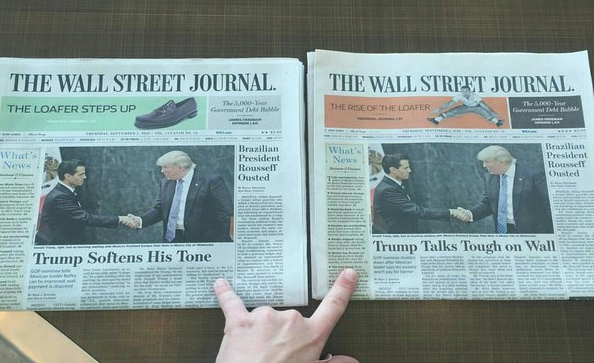
Can the same brand take two quite different positions? Yes. And no.
I don’t know if you saw this story recently (and no, I’m not going to talk about the politics) but it is intriguing from a brand point of view because it’s unusual to see one brand coming at the same topic from different angles to appeal to different audiences.
Normally a brand owner would use different brand vehicles to address different priorities and interests. They might for example have a high value brand and a budget brand within the same company, but the two would be treated as quite separate entities and would conduct separate marketing. In this case, WSJ has reduced that segmented approach to different editions of the same brand. At one level, this amounts to different editorial takes on the same issue. And one could argue it’s politics, so some latitude in position is normal.
But could another brand in another sector with different dynamics take the same approach – say, with its content marketing? Should it segment what it says and what it stands for, so that it says different things in different places and at different times, in order to broaden its overall appeal?
Brands grapple with contradictions all the time. I’ve talked a lot about crashing oxymorons together to help a brand build a unique DNA and adopt a distinctive character. And here’s a great summary on why from the Y&R blog: “One-dimensional brands will never break away from their category peers. They will be seen as obvious, clichéd and boring stereotypes. Those with depth and tension are far more irresistible, unforgettable and engaging … [Apple] illustrates a tension between smart and sexy … Land Rover is all about hardworking luxury and Virgin Atlantic Airways combines seductive service. Brands that have tension emanate excitement and possibilities, and can thereby harness deeper emotional commitment, trustworthiness, preference, and pricing power.”
There are contradictions too in how brands generally need to behave in today’s competitive environment. They must be adaptable. But at the same time, they must be recognizable. They must also be responsible but profitable; open but managed…
Finally, at a communications level, there is certainly room for flexibility in how a brand expresses itself across different markets. Globally, brands are increasingly looking to capture local audiences by applying cultural influences and flavors that, at first viewing, appear to challenge the brand’s ubiquity, but that, on closer inspection, give the brand relevance in each particular place.
So at one level, tensions work well within a brand to give it interest and a more rounded character. For all that, most brands should not even try to talk to ‘contradictory’ audiences at the same time because they risk coming off as indecisive and inauthentic. Instead, brands should look to be recognizable for a consistently singular (and intriguing) approach that is framed by their purpose, guided by their values and in line with their behaviors.
It’s tempting today to try and include everyone in the hope that will broaden your audience. In reality, you probably need to stand for a clash of ideas that is fascinating but talk to those ideas in ways that focus on what your true audience wants to hear more of.
Written by Mark Di Somma at Branding Strategy Insider


